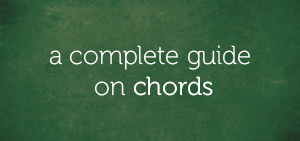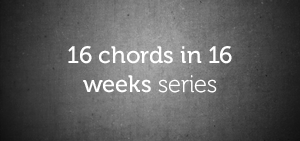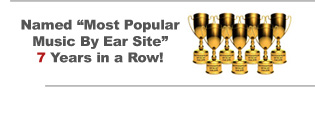The proper spelling of intervals can be challenging because of what I call “enharmonic illusion.”
There are occasions when a given interval can be wrongly perceived on the keyboard because of enharmonic equivalence between certain notes.
In other words, C# and Db can be played using the same finger key on the keyboard (aka – “tonal counterpoints”). They belong to the same pitch class. Even though they don’t have the same letter name, they share the same pitch.
When an interval is given as C-C#:
…it’s possible for the upper note (C#):
…to be perceived as Db:
This is called enharmonic illusion.
C-C#:
…is different from C-Db:
…even though they look alike on the keyboard and have the same pitch.
Let’s begin this study with an exposition on tonal counterparts.
Tonal Counterparts
Notes that are enharmonically equivalent are known as tonal counterparts.
Tonal counterparts are notes that are spelled differently, but belong to the same pitch class.
Here are a few examples:
C# vs Db
Even though C#:
…and Db:
…are two different letter names, they belong to the same pitch class on the keyboard. Therefore, they are tonal counterparts.
D# vs Eb
D#:
…and Eb:
…are two different letter names that belong to the same pitch class on the keyboard. Therefore, D# and Eb are tonal counterparts.
It holds for other tonal counterparts like…
F# and Gb
F#:
Gb:
G# and Ab
G#:
Ab:
A# and Bb
A#:
Bb:
…and other thought-provoking tonal counterparts like:
E# and F
E#:
F:
B# and C
B#:
C:
Fb and E
Fb:
E:
Cb and B
Cb:
B:
It is the enharmonic equivalence between tonal counterparts that make them sound alike.
While playing C# and Db on the keyboard, no one can tell what key you’re actually in until you say so. This is because there is practically no difference between the two.
Heck, you can be playing a C# note and people around you will think it’s a Db.
Even though, there is enharmonic equivalence between the notes [C# and Db], they differ in letter name. Here’s a contrast between the two of them:
C# is a C note
C# is a product of the pitch modification of C. We’ll raise C by a half step to get the pitch of C#.
Db is a D note
Db is a product of the pitch modification of D. We’ll lower D by a semitone to get the pitch of Db.
Even though C# and Db can be heard as the same pitch, they are both products of the pitch modification of different letter names [C and D, respectively].
The same thing holds for other tonal counterparts:
D# and Eb
D# is a product of the pitch modification of D whereas Eb is a product of the pitch modification of E.
F# and Gb
F# is a product of the pitch modification of F whereas Gb is a product of the pitch modification of G.
G# and Ab
G# is a product of the pitch modification of G whereas Ab is a product of the pitch modification of A.
A# and Bb
A# is a product of the pitch modification of A whereas Bb is a product of the pitch modification of B.
Enharmonic Intervals
Intervals that sound the same but are spelled differently are enharmonic intervals.
Considering that C# and Db are tonal counterparts, the intervals C-C#:
…and C-Db:
…will occupy the same pitch class on the keyboard and also sound alike. C-C# and C-Db are enharmonic intervals.
When an interval is given, to find its enharmonic interval, you’ll have to find the enharmonic equivalent of the upper note.
In a case where C-D# is given, its upper note is D#.
The enharmonic equivalent of D# is Eb. Therefore, C-D#:
…and C-Eb:
…are enharmonic intervals.
In a case where C-Gb is given, its upper note is Gb.
The enharmonic equivalent of Gb is F#. Therefore, C-Gb:
…and C-F#:
…are enharmonic intervals.
The same thing is applicable to other intervals that have roots other than C…
When G-C# is given, its upper note is C#.
The enharmonic equivalent of C# is Db. Therefore, G-C#:
…and G-Db:
…are enharmonic intervals.
In a case where F-Ab is given, its upper note is Ab.
The enharmonic equivalent of Ab is G#. Therefore, F-Ab:
…and F-G#:
…are enharmonic intervals.
Attention: In some [extreme] cases, you can also generate enharmonic intervals by finding the enharmonic equivalent of the lower note.
The enharmonic equivalent of the lower note of the interval can also be useful in forming enharmonic intervals.
C-E via its lower note can be determined thus:
The enharmonic equivalent of C is B#. Therefore, C-E:
…and B#-E:
…are enharmonic intervals.
C#-E via its lower note can be determined thus:
The enharmonic equivalent of C# is Db.
Therefore, C#-E:
…Db-E:
…are enharmonic intervals.
Distinguishing Enharmonic Intervals
In the last segment, I exposed you to diverse spellings of intervals (aka – “enharmonic intervals”).
Spelling an interval differently doesn’t change its sound, however, it changes two things about it:
- Its width
- Its quality
Here’s what I mean…
C-D# and C-Eb are enharmonic intervals (they sound alike, of course). However, they don’t have the same width and quality.
Let me show you the differences between both of them in width and quality.
Width
The width of an interval is the number of notes (letters) it encompasses.
Enharmonic Intervals differ from each other in width. While calculating the width of intervals, pitch modifiers are disregarded. For example…
To determine the width of C-Eb, disregard the flat symbol. This will put C-E in perspective.
C to E:
…is a third. Consisting of three notes – C, D, and E.
To determine the width of C-D#, disregard the sharp symbol. This will put C-D in perspective.
C to D:
…is a second. It consists of two notes or letters – C and D.
Therefore, the intervals C-Eb and C-D# may sound exactly the same (enharmonic intervals), however, they have different widths.
- C-Eb is a third.
- C-D# is a second.
C-F# and C-Gb are enharmonic intervals (they sound exactly the same). Let’s determine their respective widths before we move on.
To determine the width of C-F#, disregard the sharp symbol. This will put C-F in perspective.
C to F:
…is a fourth and encompasses four letters – C, D, E, and F.
Note: Even though the middle notes are not played in the interval, they are still encompassed within it.
To determine the width of C-Gb, disregard the flat symbol. This will put C-G in perspective.
C to G:
…is a fifth, encompassing five letters – C, D, E, F, and G.
Therefore, the intervals C-F# and C-Gb may sound exactly the same (enharmonic intervals), however, they have different widths.
- C-F# is a fourth.
- C-Gb is a fifth.
Quality
Enharmonic intervals also differ from each other in quality. Let’s consider the following questions:
If C-Eb is a third, what kind of third is it?
If C-D# is a second, what kind of second is it?
Check out my answers to these questions below…
Question #1 – If C-Eb is a third, what kind of a third is it?
To answer this question, you must be familiar with the C major scale:
The interval C-Eb is smaller than the interval formed between C and E (the major third), a closely related interval in the key of C major.
C-Eb is a minor third interval.
Question #2 – If C-D# is a second, what kind of a second is it?
The interval C-D# is larger than the interval formed between C and D (the major second), a closely related interval in the key of C major.
C-D# is an augmented second interval. Augmented means “to make larger.”
C-Eb and C-D# are enharmonic intervals. Even though they sound the same, they belong to different classes of intervals:
C-Eb is a minor interval.
C-D# is an augmented interval.
Putting all that we just covered together, you can see the difference in quality between C-Eb and C-D# (which are enharmonic intervals). Check out the table below:
|
|
Width |
Quality |
|
C-D# |
Second |
Augmented |
|
C-Eb |
Third |
Minor |
The width and quality of an interval depends on it’s spelling and this is the reason why enharmonic intervals differ in width and quality.
Two notes can sound alike and even form an interval that sounds alike, but are indeed different and I hope this post has now made it clear why that is the case.
See you next time.
Chuku Onyemachi
Latest posts by Chuku Onyemachi (see all)
- The Formation Of Diminished Seventh Chords Used To Be Challenging Until I Did This
- How To Form Seventh Chords In Two Shakes Of A Dog’s Tail Using Third Intervals And The Circle Of Fifths Chart
- I Played The 13sus4 Chord And This Happened…
- How To Build Seventh Chords Like An Architect Using “Foundation And Structure” Concept
- This 4-Week Plan Will Help You Master All The Major Scales







Comments on this entry are closed.